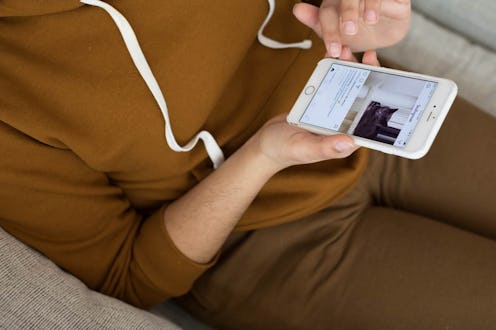Life
This App You Use Every Day Is Secretly The Best Way To Network

Last fall, as I walked down a crowded street in Brooklyn, a Link NYC console caught my eye. The art on display showed a woman in a downward dog yoga pose over the Brooklyn Bridge; underneath it was an Instagram handle, belonging to 27-year-old artist Janet Sung. While I was surprised to see a handle instead of a name, it also made perfect sense. A digital billboard brought Sung’s work to the city’s streets, and anyone who wanted to learn more could go straight to her feed. She’s not alone. In the past year, I’ve made many professional connections via Instagram, including meeting the editor of this story. For millennial women across industries, Instagram provides more than a name, email, or business card, is often the most complete digital calling card — it presents a complete picture of your life, beyond your “personal brand,” or a static collection of job titles.
When Aleia Walker, a 29-year-old email marketer in Atlanta, Georgia, started her own company in 2018, she set up a website and started looking for clients. Almost immediately, she realized how much Instagram could help her reach more prospective clients. “I follow a lot of my target audience/former collaborators,” Walker tells Bustle. “I used to focus on the general, like/comment but now I really focus on engaging with them in Instagram Stories — especially when we find non-biz things in common.”
Twenty-four-year-old Julianne Simson uses Instagram to grow her side hustle @howtobebrokeinnewyork, which features budgeting tips and low-cost or free fitness options around the city. She meets top instructors and studios through Instagram, often supporting them in person when they’re just starting out. One highlight was “a new SoulCycle instructor, whose community classes I promoted and hyped a LOT. She invited me to come to her class when she was finally official.” The Instagram to IRL interaction was a win for each of them: a new instructor had an enthusiastic participant (with an audience) and Simson created value for her followers.
Ziwe Fumudoh, a 26-year-old comedian and writer for Desus & Mero who performs regularly around New York, uses Instagram to simply post what she likes. "With my profile, @ziwef, you'll see an array of photos of me on set, working at a show, or hanging in my living room because those are the things I'm doing,” Fumudoh says. She’s able to book shows and find collaborators by posting in her signature style.
Sharing in your signature style is a major benefit of Instagram, experts say. Ashley Louise, co-founder of Ladies Get Paid, a network for women seeking equal power and equal pay, recommends women use Instagram for contextualization — showcasing aspects of your non-professional life that demonstrate how you’d make a great team member, or a compelling candidate for a collaboration. The daily documentation of your work and life for Louise “is the most important upside of Instagram.” Given the competitive job market, “it's incredibly important to women that they find folks they can work either for or with that will allow them to thrive as their authentic selves. Leveraging a platform like Instagram professionally allows individuals, companies, and brands to communicate their values effectively. That cuts both ways though, so if you are going to leverage your Instagram professionally, make sure it's professionally appropriate!”
Outside of posts and comments, Instagram Stories, which disappear after 24 hours, are a place to share random ideas and goals for all users, whether or not networking is their goal. For Walker, stories are her favorite part of Instagram.“You can get really vulnerable in Instagram Stories because they have a short shelf life. And each of those stories is an invitation to strike up a really off the cuff conversation. I get sad when I see biz owners turn off the reply feature on Stories, it feels like such a wasted effort to have a one-sided story.”
”A wise man once said, ‘it goes down in the DM,’” Fumudoh says, meaning a private Direct Message where anything can happen. Walker says she has “booked development/tech projects via DMs when I talked about things I was working on or dream projects in my stories.”
As with all networking, balance is key.
Simson says she uses stories as a way to engage without the stress of algorithm. “I share upcoming free classes with instructions to sign up, for example. I am, like every other Instagrammer, currently trying to figure out how to work around the new algorithm so that my followers actually see my posts; until then, stories are my best M.O.!”
Walker also prefers to share via stories that blend the personal and professional. “I’m a person before I’m a biz owner. In fact, I am a biz owner because I want to be a person and not just a corporate drone. I share a lot of my personal life via stories especially my obsession with quality rums (and my ridiculous amount of knowledge about them), how weight training affects my work, and the fact that I’m a night owl.”
For Sung, who says she got major exposure through the LinkNYC partnership, which was unpaid, the audience still had value. As with all networking, balance is key. Sung regularly shares her art and shows she’s participating in but says, “I could probably do a better job of reaching out to others to network, but for my mental health I actually try not to follow too many people and just answer comments/DM that come into my inbox.”
While many people, as Sung points to, use Instagram (intentionally or not) to compare themselves to others, these women show that social media can be used for both human and professional connection. So when someone’s feed grabs your attention, Louise recommends simply “reaching out via DM to introduce yourself and express interest in collaborating.” You never know what will come next.